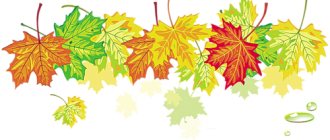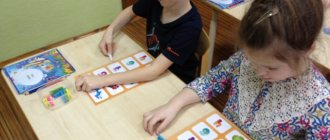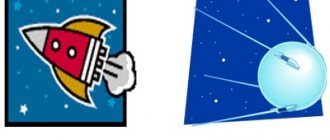Mnemonics for schoolchildren
The modern student receives a huge amount of information on various disciplines every day. It is very difficult to remember the material received in such a volume. Mnemonics skills will help here, which make it possible to accumulate and retain information.
Mnemonics for memory development is a strong training of attention and thinking. The following techniques will help you remember the information received as much as possible:
- "Make up your own story" . How to remember a list of unrelated words? The simplest thing is to come up with a story. For example, vocabulary words starting with the letter “l”: – labyrinth – on the rides we got confused in the labyrinth; – laboratory - he secretly entered a secret laboratory; – lagoon – the blue lagoon sparkles with sunlight. Next, the student reads the resulting text and retells it. This way he remembers the right words.
- Association cards . This method of taking notes helps you remember what you read. The main topic is written in the center of the sheet, and then secondary topics branch off from it in different directions, like branches of a tree.
- Block diagram . This method helps to structure numbers, tables, symbols, and keywords. The arrows in the diagram indicate the relationship between various data.
- Another proven way to remember information is to try to rhyme it. It is necessary to compose several lines of the necessary information and rhyme them. This should create a short verse. Then repeat several times.
- BCC - alphanumeric code . The technique is used to encrypt numbers and digits into words.
Exercises for preschoolers
Preschool age is considered a favorable period for laying the foundations of competent, clear, beautiful speech. Mnemonics for beginners (simple, fun tasks, games) will help your child’s speech develop faster. It is useful for the development of the articulatory apparatus to perform tasks using onomatopoeic words. They correct diction well - pure jokes (“If only there was smoke coming out of the chimney”), nursery rhymes, phrases containing a certain group of sounds (“Sanya’s sleigh rides on its own”).
Exercises on the pronunciation of hissing sounds can be combined thematically.
After looking at the picture “Hedgehog and Hedgehogs,” the adult offers to complete a number of tasks. The child must clearly pronounce phrases with the sounds “sh” and “zh”. “Sha-sha-sha - we walk slowly; shu-shu-shu - I’ll give the baby a raspberry; shi-shi-shi - where the kids walk.” Such exercises help you master question intonation and develop a sense of rhythm.
By isolating the sound while clearly pronouncing a word, the skill of understanding the terminology “sound” and “word” is developed. When working with children, it is necessary to emphasize the development of intonation sense, rate of speech, diction, and strength of voice. Games can help with this.
Exercises for beginners:
- "Whose voice is this ? The goal of the game is for the child to learn to recognize adult animals from young animals by the reproduced sound. For such a game, you can take figurines of a dog and a puppy, a duck and a duckling, a cat and a kitten. Alternatively, you can sculpt animals from plasticine or use cards. The plot of the game: animals come to visit the baby, they want to play with him. Children should understand the difference between how a mother cat meows and how her baby meows.
- Game "Compare the cubes" . The task is to teach the child to correlate objects with different characteristics. An adult offers to look at two cubes and tell how they differ. The kid takes one cube and says that it is big, and the second cube is small. The first cube is red and the second is white. The red cube is plastic, the white cube is made of fabric and is soft inside.
- Game “Compare two kittens” . The child is asked to look at the kittens. One of them is white and large, and the second is black and smaller. You need to say who they are. Come up with names for them so that it is clear that one kitten is black and the other is white. What is the difference.
- Game “What little animals can do . The goal of the game is to choose verbs that denote the characteristic actions of animals. An adult shows pictures of animals, and the child must say what they can do or what they say. For example, a cat loves mice. She loves to meow. The dog loves to bark and eat bones, run and jump. The cockerel crows and loves to peck grains.
- Game "Profession" . Here you will need cards that depict people of different professions (pilot, hairdresser, doctor, cook). An adult asks who heals people. The kid must answer correctly. This is how the remaining cards are played.
- The game “Wizards” helps expand vocabulary, develops long-term memory and logical thinking. You will need cards with images of individual objects - a table, an apple, a door. The adult names several words, and the child must choose those cards that will help him remember the named words. He kind of “bewitches” them into these cards. Then the baby takes the cards and with their help remembers the named words. The game is aimed at understanding the logical connections between objects.
Regular playful activities help to awaken interest in words. The exercises prepare children for further independent compilation of narratives, stories, texts, and form connected speech.
Principles of operation of mnemonic tables
Note that to encode a poem, even the simplest image for a line or an entire quatrain is sufficient. It is not necessary to be a professional artist to depict the objects or actions described in the work. In a mnemonic table it is possible to schematically display the entire world around us: natural phenomena, events, signs of objects, actions of characters. The method of mnemonic tables has been developed in detail, with the necessary instructions, which does not cause difficulties in application.
The scope of the article does not imply an extended description of the methodology, so we will focus on its main principles. Work begins with the construction of a mnemonic square that corresponds to a specific word. For example, the poem “White Birch” by Sergei Yesenin is memorized. Using the word “birch,” the teacher suggests considering the symbolic designation of a tree. This should be a simple and accessible drawing for children that they can complete on their own. Then we do the same with other words, for example, “window”, “snow”, “branches”, etc. So children begin to gradually understand what the symbol of the word means.
At the beginning of training, colored mnemonic tables are offered, since color images quickly appear in children’s memory: snow is white, spruce branches are green, the sky is blue. Then, as specific skills in depicting objects are mastered, black and white symbols are used so as not to be distracted by their brightness.
Subsequent work on the poem involves a gradual transition from mnemonic squares to mnemonic tracks, which designate entire poetic phrases. This is how the poem is gradually memorized and reproduced using conventional symbols.
After mastering the necessary initial knowledge about symbols, children are led to actions with mnemonic tables. The number of cells in the table depends on the complexity and size of the text, as well as on the age of the students. Thus, the entire poem is recorded schematically.
Teachers note that as they learn, children are actively involved in creating their own scheme. After this, they reproduce the entire text from memory, using only a symbolic image.




